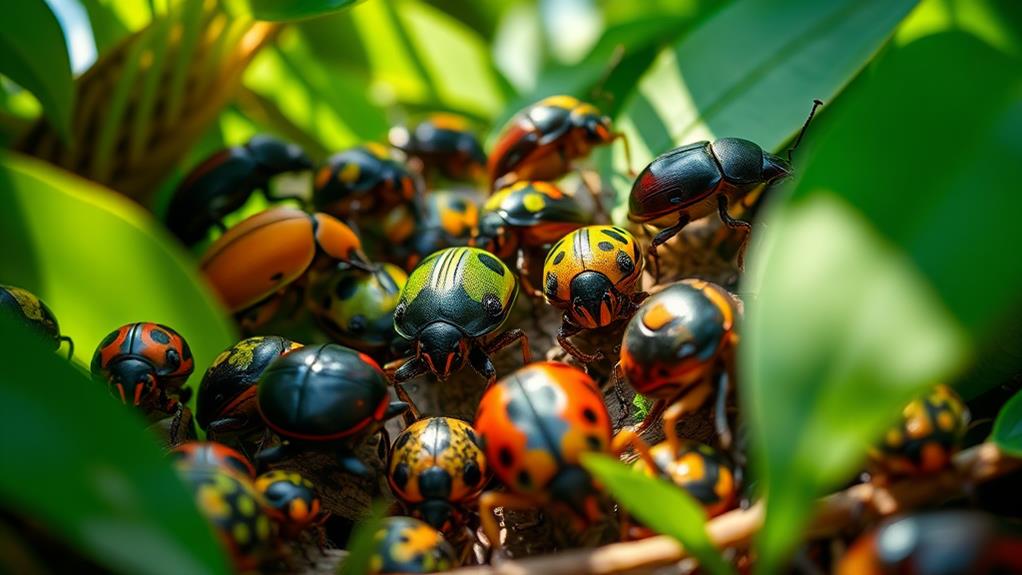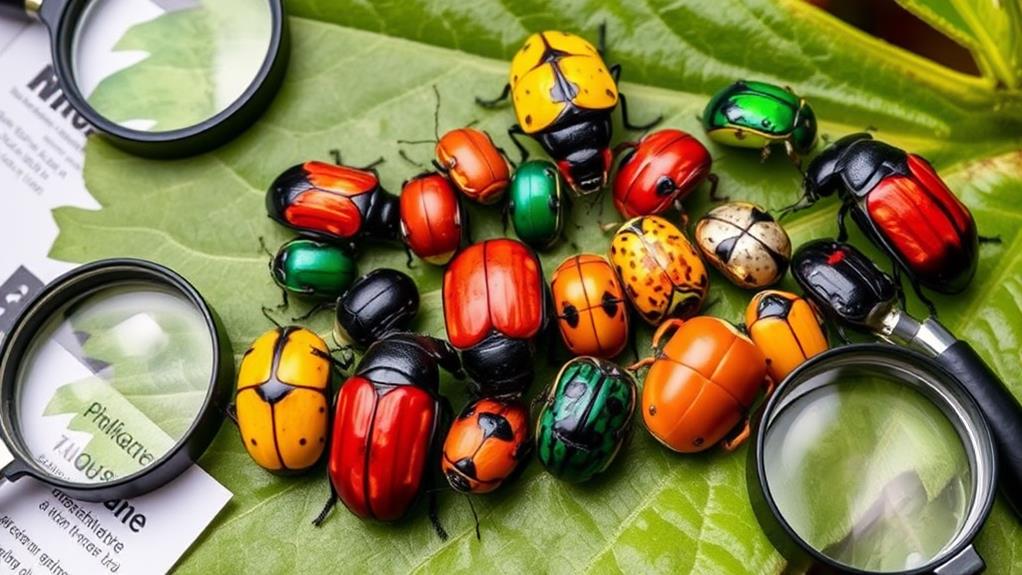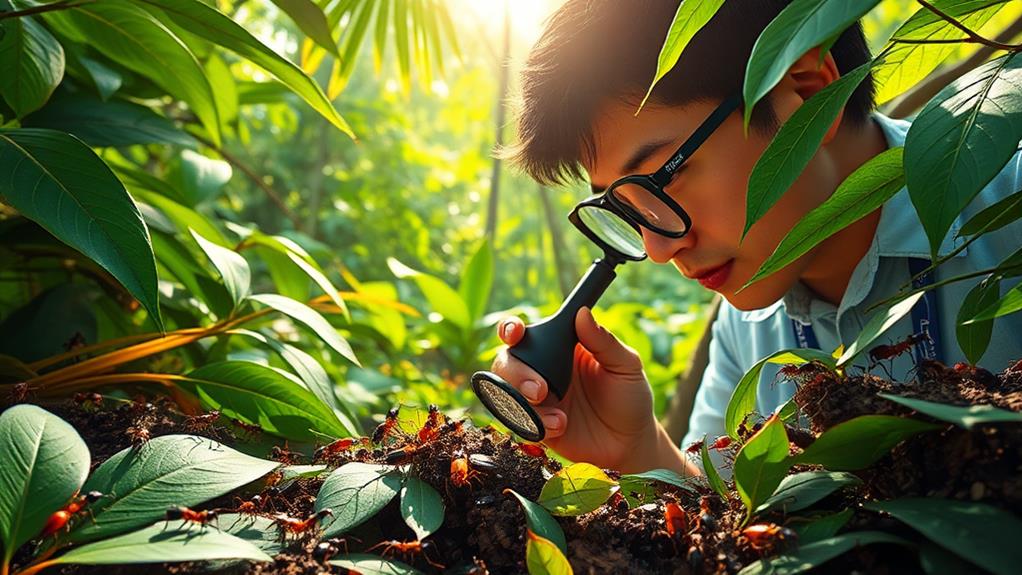The Philippines is home to a diverse array of insects, with over 8,000 beetle and 1,000 ant species documented. These insects play crucial roles in ecosystem functions, including pollination, nutrient cycling, and pest control. Additionally, the Philippines is also known for its diverse butterfly species, with about 900 species identified within its borders. These butterflies contribute to the ecosystem by aiding in pollination and serving as indicators of environmental health. Their presence adds to the rich tapestry of insect life that makes the Philippines a truly unique and biodiverse region.
Beetles showcase remarkable adaptation strategies, featuring a wide range of characteristics. For example, some species are bioluminescent, while others are miniature. These unique features have allowed beetles to thrive in various environments.
Ants, such as the critically endangered Philippine Red Ant, maintain ecological balance through activities like seed dispersal and decomposition.
Understanding their behavior, habitat preferences, and conservation challenges is vital for fostering biodiversity.
Importance of Insects in Ecosystems

Insects are crucial components of ecosystem health and functionality. They facilitate critical processes like pollination, nutrient cycling, and decomposition, which are essential for plant growth and soil health.
For example, dung beetles break down animal waste, enhancing soil fertility and preventing disease spread.
Insects also contribute to natural pest control. Lady beetles regulate harmful insect populations, supporting agricultural health. Furthermore, their diverse feeding habits allow them to occupy various ecological niches, maintaining food web balance.
Insects' roles extend to soil aeration and seed dispersal, promoting plant species diversity and ecosystem resilience.
New species discoveries through collection methods can further contribute to these ecological functions. Understanding insects' importance sheds light on the intricate relationships between insects and their environments.
Recognizing and protecting these tiny yet mighty creatures is crucial for biodiversity and sustaining ecosystems.
Overview of Philippine Biodiversity
The Philippines is one of the world's 18 mega-diverse nations, boasting an impressive array of species and ecosystems. This is due to the country's unique geography, comprising over 7,641 islands that support a wide range of habitats, from lush rainforests to coral reefs.
The Philippines ranks fifth globally for plant species diversity and fourth for bird diversity. One example of the country's extraordinary species is the critically endangered Philippine eagle. In terms of insects, around 8,000 beetle species have been documented, highlighting the vastness of the country's insect diversity.
However, this rich biodiversity faces significant threats, primarily habitat loss driven by mining, illegal logging, and land conversion practices. These human activities jeopardize the unique ecosystems found in the Philippines.
Continuous research is crucial for discovering and classifying the many species that remain, as many are still undocumented.
Conservation efforts are urgently needed to protect the Philippines' extraordinary biological wealth. Understanding and preserving this biodiversity is essential not only for ecological balance but also for sustaining the cultural and economic facets of Filipino life.
Fascinating Beetle Species

Beetle Diversity in the Philippines
The Philippines is home to approximately 8,000 identified beetle species, showcasing the stunning complexity of life forms in this archipelago. These beetles exhibit striking colors and patterns, some shimmering in gold, yellow, and turquoise, requiring three or more distinguishing features for accurate identification. This highlights the richness of this biodiversity hotspot.
Bioluminescent Beetles
Bioluminescent beetles are particularly fascinating, as they illuminate the night with their natural glow, a trait that has evolved for communication and mating. For instance, some species use their glow to attract mates or warn off predators.
Miniature Beetle Adaptations
Miniature beetle adaptations allow certain species to thrive in specific ecological niches, demonstrating the intricate interplay between form and function within their environments. These adaptations enable beetles to occupy unique habitats, such as underground tunnels or leaf litter.
Importance of Beetle Research
Research into beetles highlights the urgent need for conservation efforts, ensuring these vital species continue to play their crucial ecological roles amid habitat loss. Beetles contribute to soil nutrient cycling, and their loss could have devastating consequences for ecosystems.
Beetle Types and Their Unique Features
| Beetle Type | Unique Feature |
|---|---|
| Bioluminescent Beetles | Natural light emission |
| Miniature Beetles | Specialized adaptations for habitat |
| Historical Collections | Records of species diversity |
| Colorful Species | Vibrant hues for camouflage |
| Ecological Role | Soil nutrient cycling |
Unique Ant Species in the Philippines
The Philippines is home to over 1,000 identified ant species, showcasing a remarkable range of adaptations and ecological roles. Three endemic ant species stand out due to their distinctive behavior patterns and ecological significance.
The Philippine Red Ant, also known as the "sugar ant," is critically endangered and recognized for its vibrant coloration and vital role in local ecosystems. This species is essential for maintaining ecological balance.
Leafcutter Ants exhibit intricate diversity strategies by cultivating fungi, which serves as their primary food source. This complex relationship with the environment allows them to thrive in the Philippines.
Seed-Dispersing Ants play a crucial role in seed dispersal, promoting plant diversity and maintaining ecosystem balance. Their unique behavior ensures the spread of plant species, enriching the Philippine biodiversity landscape.
Understanding these unique species is essential, as ongoing research is vital to document the full spectrum of ant diversity in the Philippines.
Many species remain undocumented, underscoring the importance of preserving these ants to maintain ecological integrity and sustainability. Each ant species contributes uniquely to the Philippine biodiversity landscape, making them worthy of attention and protection.
Beetle Identification Techniques

Accurate Identification of Beetles in the Philippines
Identifying beetles in the Philippines requires a thorough examination of distinct physical characteristics, as the region is home to over 8,000 species. To accurately classify new species, three or more distinguishing morphological features must be observed, such as color, size, and unique markings.
Essential Tools for Identification
Field Guides are used to compare physical traits.
Collection Techniques are employed to gather specimens for analysis.
Taxonomic Keys aid in species classification.
Effective Collection and Sorting
Researchers use various collection methods, including light trapping and shaking trees, to gather specimens.
Once collected, careful sorting by family is crucial, utilizing physical traits for accurate categorization.
Detailed records, including location, date, and collector information, are also essential for successful beetle identification.
The Importance of Meticulous Identification
This meticulous approach not only aids in species classification but also contributes to ongoing research and conservation efforts.
Beetle Habitat and Distribution
Beetle Habitat and Distribution
The Philippines is home to approximately 8,000 identified beetle species, which thrive in diverse habitats. Beetles can be found in lush tropical forests, urban gardens, and freshwater ecosystems, demonstrating their remarkable adaptability and ecological niches.
Distribution Patterns
Understanding beetle distribution patterns is crucial for grasping their ecological roles. Three key aspects to consider are:
Tropical Climates: Many beetles flourish in warm environments, where abundant resources support their populations. For example, some beetles are found in tropical rainforests, where high temperatures and humidity allow them to thrive.
Diverse Ecosystems: Beetles inhabit various ecosystems, including gardens, forests, rivers, and coastal areas, showcasing their versatility in adapting to different habitats. This adaptability allows them to play essential roles in ecosystem functioning.
Ecological Contributions: Beetles play crucial roles in nutrient cycling and forest regeneration, influencing soil health and plant growth. For instance, some beetles help break down organic matter, recycling nutrients and promoting healthy soil conditions.
Field Research
Field research involves collecting beetles from diverse habitats using techniques like shaking trees and light trapping. This hands-on approach reveals not just their distribution but also their interactions within ecosystems.
Conservation Challenges in the Philippines

Habitat Loss Threatens Biodiversity
The Philippines is facing an unprecedented conservation crisis due to rapid habitat loss caused by mining, illegal logging, and land conversion. The country's rich biodiversity, including the critically endangered Philippine eagle and approximately 8,000 identified beetle species, is under severe threat.
To mitigate this, habitat restoration must become a priority. Restoring ecosystems can help re-establish the ecological balance that supports countless species.
Community Engagement is Key
Involving local populations is crucial for effective conservation programs. By engaging communities, appreciation for biodiversity can be fostered, and sustainable practices that mitigate habitat destruction can be promoted.
Educational initiatives can empower communities to protect their environment while enhancing their livelihoods. For example, teaching sustainable agriculture practices can help reduce deforestation and promote eco-friendly farming methods.
Robust Policy Implementation is Essential
Strong policy implementation is necessary to safeguard the Philippines' diverse ecosystems. This requires collaboration among government agencies, non-governmental organizations, and local stakeholders to create and enforce regulations that prevent illegal activities.
Establishing protected areas, coupled with effective monitoring systems, ensures that habitats remain intact for future generations. For instance, designating areas as national parks or wildlife sanctuaries can help protect endangered species and their habitats.
Understanding Beetle Behavior
Understanding Beetle Behavior
Beetles navigate their complex environments and interact with other species through various communication methods and behaviors. They use pheromones and body movements to signal readiness for mating or establish territory. For example, some beetles release chemical signals to attract mates, while others use body language to defend their territory.
Mating Rituals and Territorial Behavior
Beetles' mating rituals are intricate and often involve displays of sexual dimorphism, where males showcase traits like long horns to attract females. In some species, males engage in aggressive territorial behaviors to defend their territory and mating opportunities.
Fascinating Aspects of Beetle Behavior
Mimicry and Camouflage: Some beetles mimic the appearance of toxic species, deterring predators and enhancing survival. For instance, the wasp beetle has a body shape and coloration similar to a wasp, which deters predators that avoid wasps.
Complex Mating Dances: Males perform elaborate dances to impress females, showcasing their strength and fitness. In the case of the Giraffe Weevil, males engage in a complex dance to attract females, which includes raising their elongated necks and vibrating their bodies.
Vocalizations: Certain species of beetles produce sounds to communicate, marking their territory or attracting a mate. For example, the hissing sound made by the Titanus giganteus beetle is used to ward off predators and attract mates.
Beetle Feeding Strategies

Beetles' Versatile Feeding Strategies
Beetles' adaptability is reflected in their diverse feeding strategies, which are crucial for their survival and reproduction. They can be classified as omnivores, herbivores, or carnivores, consuming various materials such as leaves, dung, fungi, and other insects.
Dung beetles play a vital role in nutrient cycling by breaking down animal waste, preventing waste accumulation and enriching soil quality. This demonstrates a direct link between beetle feeding mechanisms and ecosystem health.
Lady beetles serve as natural pest control agents, primarily targeting aphids and other harmful insects, highlighting their predatory habits.
Some beetles exhibit specialized dietary preferences, enhancing their feeding strategies. For example, leafcutter ants, although not beetles, cultivate fungi, illustrating a unique mutualistic relationship that aligns with beetle reproduction strategies.
Beetles' adaptability in feeding habits enables them to thrive in various environments, contributing significantly to decomposition and pollination processes essential for ecosystem balance.
Role of Ants in Ecosystems
Ants play a crucial role in maintaining ecosystem dynamics through their diverse behaviors and colony dynamics. As a vital part of the ecosystem, ants perform several essential functions:
Nutrient Recycling: Ants are skilled decomposers, breaking down organic matter and returning valuable nutrients to the soil. For example, leafcutter ants collect plant material, decompose it, and use the resulting nutrient-rich soil to fertilize their underground gardens.
Plant Protection: Ants protect plants from herbivores in exchange for nectar. This mutualistic relationship significantly influences plant health and survival. For instance, the bullhorn acacia tree provides sweet, sticky nectar to ants, which in turn defend the tree from insects and other herbivores.
Seed Dispersal: Many ant species transport seeds to their nests, aiding in plant propagation and increasing habitat diversity. This process enhances ecosystem diversity. For example, the driver ants of the genus Dorylus collect seeds, store them in their underground nests, and then deposit them in new locations, allowing the seeds to germinate and grow.
Ants also serve as natural pest controllers, preying on harmful insects and reducing reliance on chemical pesticides.
Their colonies enhance soil aeration, which promotes water infiltration and root growth for surrounding vegetation. This multifaceted role underscores the importance of ants in sustaining healthy ecosystems, highlighting how their activities are interwoven with the survival of numerous species, including plants and other insects.
Research Methods for Insect Study

Accurate Research Methods are Crucial for Insect Study
Field Collection Techniques
To gather thousands of insect specimens from diverse habitats, researchers employ various field collection techniques. For example, shaking trees and shrubs dislodges beetles onto collection cloths, while light trapping attracts a wider array of insects.
These methods are essential for collecting insects from different environments, such as riverbanks and forests.
Insect Identification and Preservation
Once collected, insect identification is a significant challenge. Initial sorting by family is necessary, followed by accurate identification, which typically requires three or more distinguishing physical features.
To ensure accurate identification, keen observation is essential. After sorting, effective specimen preservation methods are vital, including meticulous drying, labeling, and detailed record-keeping of collection data, such as location, date, and collector information.
Continuous Research and Adaptability
Continuous research and fieldwork are necessary for discovering and describing new beetle species.
Adaptability in collection techniques is crucial, as different species exhibit varying behaviors and habitat preferences. By refining research methods, scientists can enhance our understanding of species distribution and diversity, ultimately contributing valuable insights to the study of insects.
Citizen Science and Insect Monitoring
Insect Monitoring through Citizen Science
Accurate field collection techniques and proper specimen preservation are essential for understanding insect populations. However, citizen science initiatives are revolutionizing the way data is gathered and analyzed. By using apps like iNaturalist, individuals can actively engage in monitoring local insect populations, contributing to crucial research in biodiversity.
The Impact of Citizen Science
Participating in citizen science projects has several significant impacts:
Empowerment: Contributing to a collective effort, such as documenting thousands of unidentified beetle species in the Philippines, gives individuals a sense of responsibility.
Connection: Observations made through citizen science projects foster appreciation for insect diversity, bridging the gap between science and community.
Stewardship: Engaging in insect monitoring enhances understanding of insect ecology, promoting environmental stewardship among people of all ages.
Effective Data Collection
Through citizen scientist training, individuals learn effective data collection methods, ensuring that every observation contributes meaningfully to scientific knowledge.
This not only enriches our understanding of insect populations but also nurtures a culture of conservation, encouraging others to appreciate and protect intricate ecosystems.
Beetles and Climate Adaptation

Beetles in the Philippines: Masters of Climate Adaptation
Beetles in the Philippines have developed exceptional resilience and innovative strategies to adapt to varied climatic conditions. With over 8,000 identified species, these insects showcase a wide range of behavioral adaptations that enhance their survival in diverse habitats.
Behavioral Adaptations for Survival
Beetles' vibrant colors and unique traits, such as camouflage, serve as evolutionary strategies against predators. For example, dung beetles have developed efficient waste processing for nutrient cycling, allowing them to thrive in varying wetness conditions.
Weevils use mimicry and camouflage to evade predators, making them adaptable to different moisture levels. Longhorn beetles have specialized feeding habits for diverse plants, enabling them to tolerate temperature shifts.
Ecological Importance and Conservation
These adaptations are crucial for maintaining the delicate balance of ecosystems, especially in the face of climate change and habitat loss.
Continuous monitoring of beetle populations is vital to understanding their responses and ensuring effective conservation strategies. By studying their evolutionary strategies, we can gain insights into the resilience of these fascinating insects.
Key Takeaways
- Beetles in the Philippines have developed exceptional resilience to adapt to varied climatic conditions.
- Behavioral adaptations, such as camouflage and specialized feeding habits, enhance their survival in diverse habitats.
- Continuous monitoring of beetle populations is crucial for understanding their responses to climate change and ensuring effective conservation strategies.
Future of Insect Conservation in the Philippines
Urgent Attention Required for Insect Conservation in the Philippines
The adaptability of beetles in the Philippines to changing environments highlights the need for immediate attention to insect conservation in the region. Habitat loss due to mining, illegal logging, and agricultural conversion poses significant threats.
Community Engagement: A Key to Successful Conservation
Engaging local populations through citizen science initiatives can enhance documentation efforts and foster a sense of responsibility toward insect conservation.
For example, local communities can participate in insect surveys and monitoring programs, providing valuable data on insect populations and habitats.
Sustainable Practices for Habitat Preservation
Implementing agricultural and forestry practices that minimize habitat destruction will safeguard vital ecosystems where insects thrive.
This can be achieved through sustainable agriculture methods, such as agroforestry and permaculture, which promote biodiversity conservation.
Robust Policy Development for Insect Conservation
Creating robust policies that prioritize biodiversity protection is crucial for sustaining insect populations, especially under-researched beetle species.
Effective policies can ensure the protection of habitats and ecosystems, as well as regulate activities that harm insect populations.
By prioritizing community engagement, sustainable practices, and informed policy development, insect conservation can become integral to environmental health in the Philippines.
This won't only maintain ecosystem functions provided by insects, such as soil nutrient cycling and pest control, but also promote an appreciation for the rich diversity of Philippine insects.
Questions and Answers
Are There More Ants Than Beetles in the World?
Beetles outnumber ants in terms of species diversity. This is because beetles make up about 40% of all insect species, showcasing immense diversity.
In contrast, ants primarily exhibit social behavior within colonies, limiting their ecological roles. This difference in diversity is a result of beetles' adaptability, allowing them to occupy varied ecological roles across different habitats.
For example, some beetles are herbivores, while others are predators or decomposers. Beetles' unique evolutionary paths and ecological significance contribute to their greater overall diversity compared to ants.
Why Are There so Many Insects in the Philippines?
The Philippines is a biodiversity hotspot due to its tropical ecosystems and varied habitats. This unique combination creates an ideal environment for insects to thrive. The country's geographic location near the equator results in a tropical climate with high temperatures and high levels of humidity, providing optimal conditions for insect growth and reproduction.
The Philippines' isolation and diverse environments have led to high levels of endemism. The country's unique geography, comprising over 7,000 islands, has created numerous isolated habitats that have allowed species to evolve independently.
This isolation has resulted in the development of unique species found nowhere else in the world. For example, the Philippines is home to over 300 species of ants, many of which are found only in specific islands or regions.
However, ongoing habitat loss poses threats to these ecosystems and their rich insect populations. The rapid destruction of forests and natural habitats has resulted in the loss of niches for insects to live and thrive.
Conservation efforts are necessary to protect these vital ecosystems and maintain their rich insect populations.
What Is the Most Abundant Insect in the World?
Ants are the most abundant insect in the world, with a staggering population of over 20 quadrillion. This immense number highlights their importance in ecosystems, where they play various ecological roles.
For instance, ants contribute to soil aeration by digging tunnels, which allows air and water to reach plant roots. They also participate in seed dispersal, helping to spread plant species to new areas.
What Country Has the Most Bug Species?
Brazil has the most documented bug species, with around 55,000. This high number is due to the country's complex ecosystems, which support a wide range of insect life.
For example, the Amazon rainforest in Brazil is home to thousands of insect species, many of which play crucial roles in pollination, decomposition, and other ecological processes.
Indonesia follows closely, with a high number of bug species as well. This is also due to the country's tropical climate and diverse ecosystems, which support a rich tapestry of insect life.
Understanding the patterns of insect diversity in these countries is vital for conservation efforts and appreciating the intricate web of life on Earth.